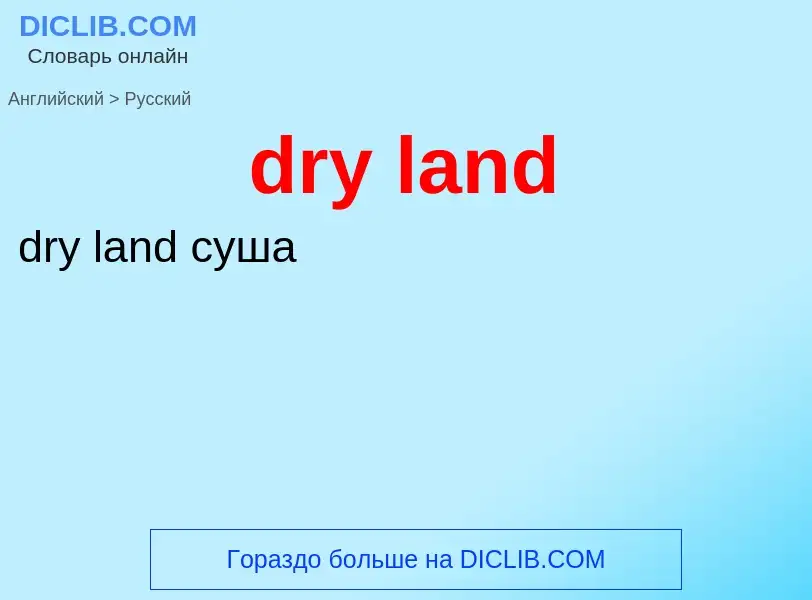Перевод и анализ слов искусственным интеллектом ChatGPT
На этой странице Вы можете получить подробный анализ слова или словосочетания, произведенный с помощью лучшей на сегодняшний день технологии искусственного интеллекта:
- как употребляется слово
- частота употребления
- используется оно чаще в устной или письменной речи
- варианты перевода слова
- примеры употребления (несколько фраз с переводом)
- этимология
dry land - перевод на Английский
[drai'lænd]
общая лексика
суша
Определение
Википедия

Land, also known as dry land, ground, or earth, is the solid terrestrial surface of Earth not submerged by the ocean or another body of water. It makes up 29.2% of Earth's surface and includes all continents and islands. Earth's land surface is almost entirely covered by regolith, a layer of rock, soil, and minerals that forms the outer part of the crust. Land plays important roles in Earth's climate system, being involved in the carbon cycle, nitrogen cycle, and water cycle. One third of land is covered in trees, another third is used for agriculture, and one tenth is covered in permanent snow and glaciers.
Land terrain varies greatly, consisting of mountains, deserts, plains, plateaus, glaciers, and other landforms. In physical geology, the land is divided into two major categories: Mountain ranges and relatively flat interiors called cratons. Both form over millions of years through plate tectonics. Streams – a major part of Earth's water cycle – shape the landscape, carve rocks, transport sediments, and replenish groundwater. At high elevations or latitudes, snow is compacted and recrystallized over hundreds or thousands of years to form glaciers, which can be so heavy that they warp the Earth's crust. About 30 percent of land has a dry climate, due to losing more water through evaporation than it gains from precipitation. Since warm air rises, this generates winds, though Earth's rotation and uneven sun distribution also play a part.
Land is commonly defined as the solid, dry surface of Earth. The word land may also collectively refer to land cover, rivers, shallow lakes, natural resources, non-marine fauna and flora (biosphere), the lower portions of the atmosphere (troposphere), groundwater reserves, and the physical results of human activity on land, such as architecture and agriculture. Although water-saturated land, or mud, is common away from the ocean, the shoreline is defined as the area where dry land meets any body of water.
Though modern terrestrial plants and animals evolved from aquatic creatures, Earth's first cellular life likely originated on land. Survival on land relies on fresh water from rivers, streams, lakes, and glaciers, which constitute only three percent of the water on Earth. The vast majority of human activity throughout history has occurred in habitable land areas supporting agriculture and various natural resources. In recent decades, scientists and policymakers have emphasized the need to manage land and its biosphere more sustainably, through measures such as restoring degraded soil, preserving biodiversity, protecting endangered species, and addressing climate change.


![Cross section of [[rankers]] soil, with plants and protruding roots near the top Cross section of [[rankers]] soil, with plants and protruding roots near the top](https://commons.wikimedia.org/wiki/Special:FilePath/2013-morbihan-ile-berder-rankosol-granite0109.jpg?width=200)
![Checkerboarding]] as a land management strategy: white patches are trees covered with snow, and dark patches are the intact forest. Checkerboarding]] as a land management strategy: white patches are trees covered with snow, and dark patches are the intact forest.](https://commons.wikimedia.org/wiki/Special:FilePath/Checkerboard forest in Idaho.jpg?width=200)
![Hadean Eon]] Earth Hadean Eon]] Earth](https://commons.wikimedia.org/wiki/Special:FilePath/Earth formation.jpg?width=200)
![Clouds above [[Djibouti]]'s, [[Eritrea]]'s, [[Somalia]]'s and [[Yemen]]'s land territories Clouds above [[Djibouti]]'s, [[Eritrea]]'s, [[Somalia]]'s and [[Yemen]]'s land territories](https://commons.wikimedia.org/wiki/Special:FilePath/ISS-59 Storm clouds on the southwestern coast of Yemen.jpg?width=200)
![topographical]] map of Japan showing the elevation of the terrain. topographical]] map of Japan showing the elevation of the terrain.](https://commons.wikimedia.org/wiki/Special:FilePath/Island arc of Japan.jpg?width=200)
![Gran Sabana National Park]], [[Venezuela]] Gran Sabana National Park]], [[Venezuela]]](https://commons.wikimedia.org/wiki/Special:FilePath/Kukenan Tepuy at Sunset.jpg?width=200)
![Land cover as classified by the [[International Geosphere-Biosphere Programme]] (IGBP) into 17 classes Land cover as classified by the [[International Geosphere-Biosphere Programme]] (IGBP) into 17 classes](https://commons.wikimedia.org/wiki/Special:FilePath/Land cover IGBP.png?width=200)
![A simplified diagram of the [[littoral zone]], which includes the coast and nearby waters A simplified diagram of the [[littoral zone]], which includes the coast and nearby waters](https://commons.wikimedia.org/wiki/Special:FilePath/Littoral Zones.jpg?width=200)

![A [[forest]] in Ryssbergen, [[Sweden]] A [[forest]] in Ryssbergen, [[Sweden]]](https://commons.wikimedia.org/wiki/Special:FilePath/Ryssebergen 2012b.jpg?width=200)
![[[White Desert National Park]] in [[Egypt]] [[White Desert National Park]] in [[Egypt]]](https://commons.wikimedia.org/wiki/Special:FilePath/White Desert, Rock formations, Egypt.jpg?width=200)
![A train traveling across the [[Voronezh Oblast]], Russia A train traveling across the [[Voronezh Oblast]], Russia](https://commons.wikimedia.org/wiki/Special:FilePath/Поезд на фоне горы Шатрище. Воронежская область.jpg?width=200)
